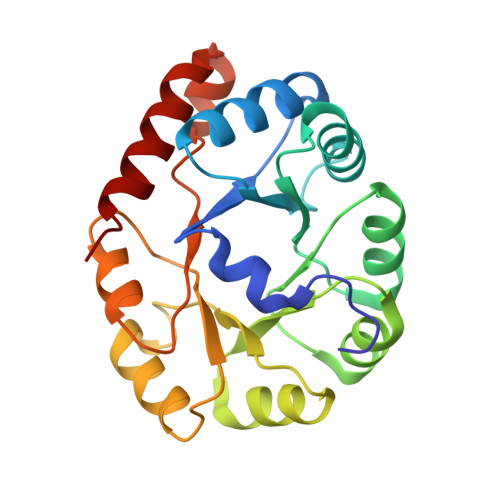Directed evolution of a new catalytic site in 2-keto-3-deoxy-6-phosphogluconate aldolase from Escherichia coli.
Wymer, N., Buchanan, L.V., Henderson, D., Mehta, N., Botting, C.H., Pocivavsek, L., Fierke, C.A., Toone, E.J., Naismith, J.H.(2001) Structure 9: 1-10
- PubMed: 11342129
- DOI: https://doi.org/10.1016/s0969-2126(00)00555-4
- Primary Citation of Related Structures:
1FQ0, 1FWR - PubMed Abstract:
Aldolases are carbon bond-forming enzymes that have long been identified as useful tools for the organic chemist. However, their utility is limited in part by their narrow substrate utilization. Site-directed mutagenesis of various enzymes to alter their specificity has been performed for many years, typically without the desired effect. More recently directed evolution has been employed to engineer new activities onto existing scaffoldings. This approach allows random mutation of the gene and then selects for fitness to purpose those proteins with the desired activity. To date such approaches have furnished novel activities through multiple mutations of residues involved in recognition; in no instance has a key catalytic residue been altered while activity is retained. We report a double mutant of E. coli 2-keto-3-deoxy-6-phosphogluconate aldolase with reduced but measurable enzyme activity and a synthetically useful substrate profile. The mutant was identified from directed-evolution experiments. Modification of substrate specificity is achieved by altering the position of the active site lysine from one beta strand to a neighboring strand rather than by modification of the substrate recognition site. The new enzyme is different to all other existing aldolases with respect to the location of its active site to secondary structure. The new enzyme still displays enantiofacial discrimination during aldol addition. We have determined the crystal structure of the wild-type enzyme (by multiple wavelength methods) to 2.17 A and the double mutant enzyme to 2.7 A resolution. These results suggest that the scope of directed evolution is substantially larger than previously envisioned in that it is possible to perturb the active site residues themselves as well as surrounding loops to alter specificity. The structure of the double mutant shows how catalytic competency is maintained despite spatial reorganization of the active site with respect to substrate.
- Department of Chemistry, LSRC, Duke University, Durham, NC 27708, USA.
Organizational Affiliation:

















